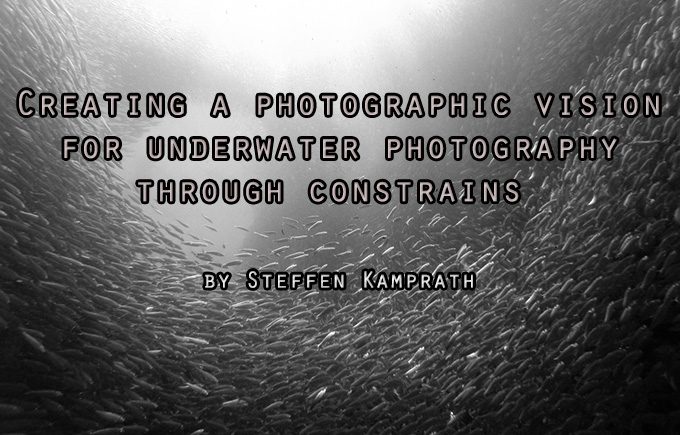
Creating a photographic vision for underwater photography through constrains
By Steffen Kamprath
Hello fellow photo enthusiast,
I’m Steffen Kamprath, a passionate travel photographer from Berlin, Germany. Some years ago, I started scuba diving and since then tried to go on one bigger dive trip per year with my buddy (scuba diving is a buddy sport). I usually try to combine diving with traveling. Which means, I travel around an area and whenever there’s an interesting dive spot, I jump in. Therefore, I keep my luggage small (usually one small backpack or travel bag), have a small photo gear kit and just have my diving mask with me. The less I carry with me, the faster I can change plans and the easier I can travel like locals.
Photo from my second to last trip to the Red Sea in 2014: Colorful sun rays hitting through the surface at El Quadim Bay, El Quseir (Egypt)
Convenient entry with a GoPro
For underwater photography I use a GoPro like many other divers too. It’s waterproof up to 200 ft right out of the box, affordable, small, light and gets the job done. Actually, there aren’t many options under $1k. All other action cameras I know are just waterproof for snorkeling, and the step-up always contains dedicated underwater housings, a completely different game and much more expensive. GoPro is the go-to for all divers and it’s fun.
But actually, the GoPro sucks for underwater photography because it’s optimized for helmet-mounted action videos in bright daylight, not stills in dim, unstable environments. Although there has been some slight improvements on handling, dynamic range and stabilization with the latest versions, the camera still lags behind even comparable smartphone cameras. I wonder why none of these action camera manufactures discovers scuba divers as a new niche market.
Red Sea 2014: Underwater arrangement at Ras El Quseir dive spot, El Quseir (Egypt)
Stepping up means going much bigger
Instead, for an underwater photographer who wants to step up the game, the next step contains either a compact camera or DSLR/MILC and a housing. Quality housings (Ikelite, Nauticam, Aquatica, etc.) can cost quite some, and they’re huge and heavy. I saw a guy with a tiny Sony RX100-series compact and the housing was like 6″ x 5″ x 4″ and weighed almost 2 lbs, plus two lights and several wet lenses (lenses you can swap under water; didn’t knew that) … that thing was huge! And every time he was under water, he just navigated his equipment, rushed from one place to another and his whole experience was just about some nudibranch he got — or not.
Furthermore, these housings are made for one specific camera model because they extend the buttons on the camera to the housing. When the dimensions or the button layout changes, you need a new housing. Also, they only work with certain camera-lens combinations. If you buy a larger lens, it won’t fit. If you buy a smaller lens, you’ll get reflections or see the housing inside the frame.
The challenges of underwater photography
In the end, this all still doesn’t tackle the challenges of underwater photography. Light is the biggest one. With each inch you go down, more and more of the light’s spectrum will be reflected and you soon end up in completely blue water. So, while a camera with a bigger sensor, a faster lens and manual shutter speed can help you with less light and unsteady stabilization, they can’t pull up colors from nowhere.
I was using a red filter with my GoPro. A red filter does not pull up red where no red light frequencies get. Instead it lowers all other colors so that the image is more balanced — on the cost on light transmission. But “balanced” in this case just means grey instead of blue. That’s why underwater photographers bring down their own light. And because water is not air and full of
floating particles that are even more visible in stills, you can’t illuminate a whole underwater landscape. That’s why, most underwater photography consists of close-up shots of animal sea life.
My favorite image from my 2014 Red Sea trip: My buddy’s free-falling into the deep blue, El Quseir (Egypt)]
Getting my vision clear
But this is not what I’m interested in. And while I was thinking about my situation, I saw many similarities to what is happening above surface. We all talk about small camera kits. We talk about natural lighting. We talk about available technology … We actually talk about compromises that eventually even enhance our photographic vision. So what is my photographic vision for underwater photography when it’s not close-up shots of nudibranchs for class room books? It’s about diving! It’s about me and my buddy deflating our inflators, sinking into a new world, a new universe without physical laws, with no gravity, no colors, no sound, silently sinking into a black hole and discovering landscapes and creatures out off this world. There is this realness and excitement when you’re in close contact with underwater life that is unimaginable for people who never dived. So what I’m looking for is some kind of rawness of emotions of people and different places underwater. And that is actually what I also try to do with travel photography: documenting how I (and therefore the viewer) moved into this new society, with its people, customs, daily lives, cities, landscapes, rural areas …
My vision for underwater photography
And therefore technology doesn’t matter anymore to me. I can now embrace the lo-fi look the GoPro gives me. In return, I have a small device that does not let much between me and my new environment, between me and my emotions that I want to record.
Earlier this year, I’ve been to the Philippines — more precisely to the islands of Cebu and Leyte. We traveled around and visited some breathtaking diving spots in Moalboal and Padre Burgos. And for underwater photography, I got in closer, incorporated humans more into the landscape and tried to intensify the feelings of rawness and realness even more in post-production by high contrasts, intensive cuts and a selection that embraces the moment. That reminds me very much of street photography, right? Here we go:
Diver facing the giant, black mass of a sardines school in Moalboal, Cebu (The Philippines)
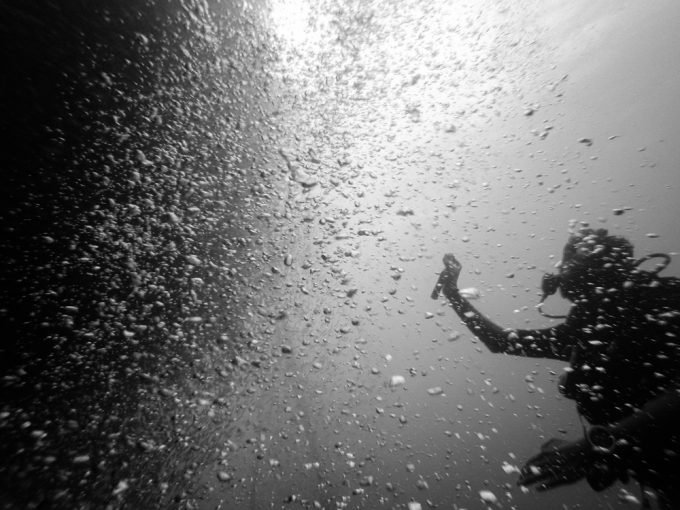
Loads and loads of fishes on Pescador Island, Moalboal, Cebu (The Philippines)
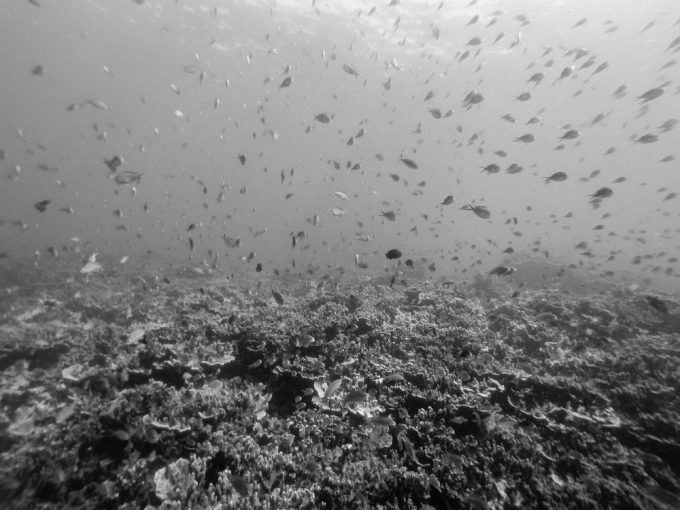
On the edge of the abyss, Pescador Island (Moalboal, Cebu, The Philippines
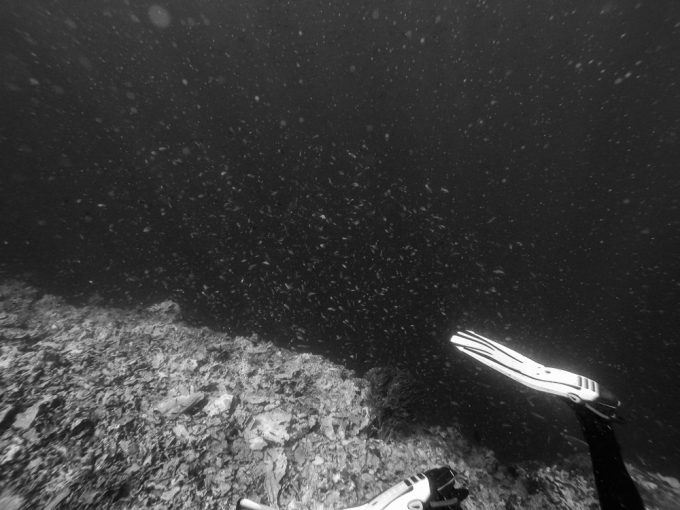
Giant school of sardines almost colliding with the reef wall, Moalboal, Cebu (The Philippines)
A living cathedral of sardines, Moalboal, Cebu (The Philippines)
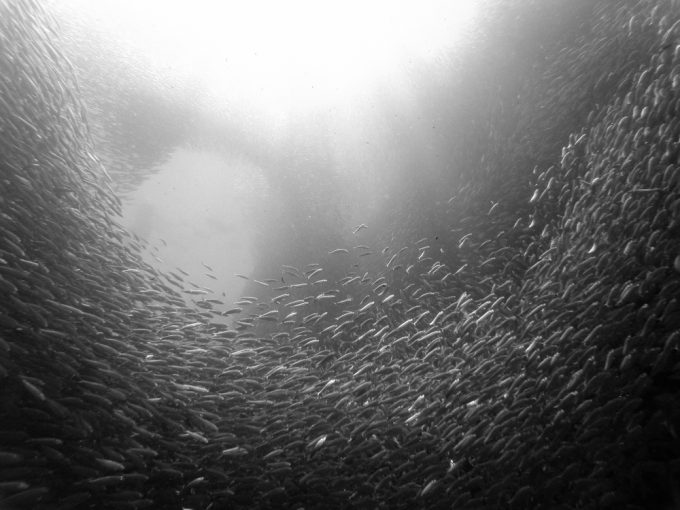
Group of divers under the dark umbrella of a giant mass of sardines, Moalboal, Cebu (The Philippines)
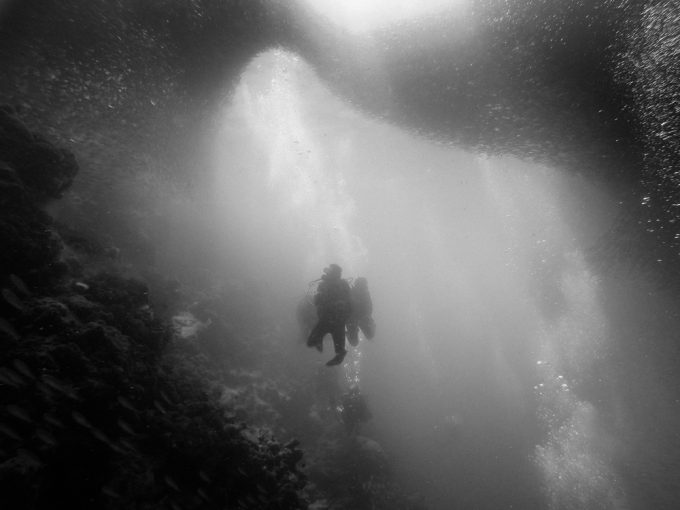
Encounter with a sea turtle at Lo-ok dive spot, Moalboal, Cebu (The Philippines)
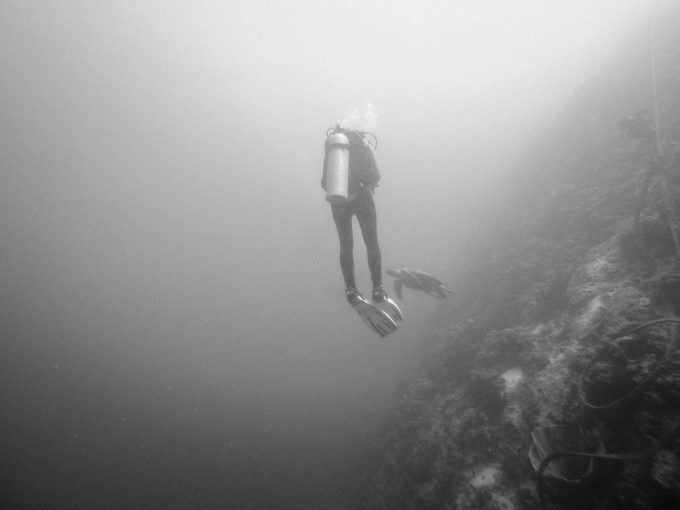
Wall dive with palm, Moalboal, Cebu (The Philippines)
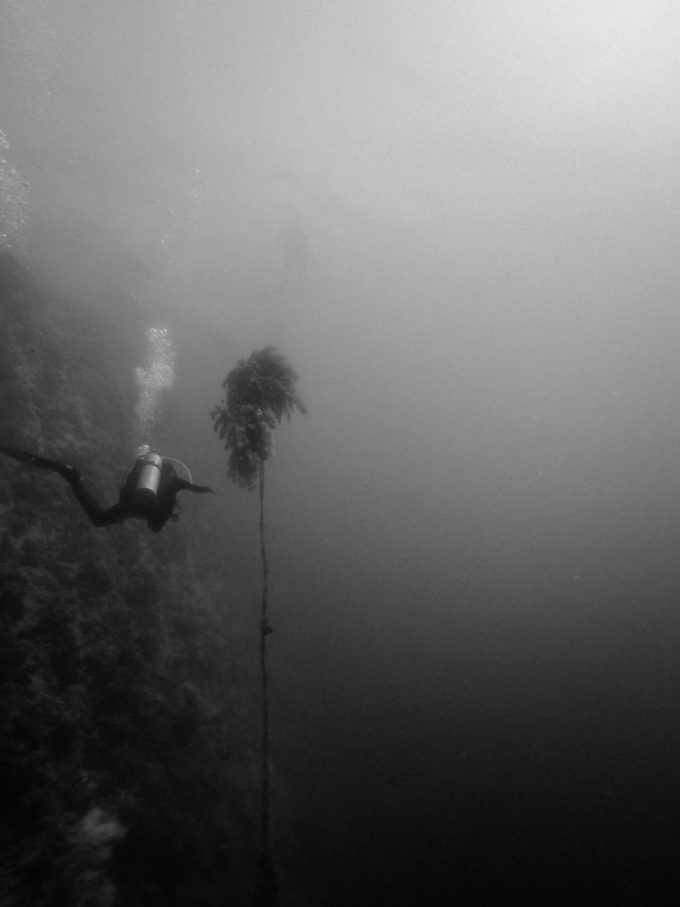
Clung to the exit ladder at Max Climax dive spot, Padre Burgos (Southern Leyte, The Philippines)
Final words
I don’t know if I succeeded. Only you can tell — please. It was my first attempt. But now that my vision is clear, I can improve on it next time.
Unfortunately, my GoPro housing broke during my last week, salt water soaked in and damaged the GoPro itself but fortunately not the SD card (kudos to GoPro for their sealing). But it showed me that one should never just use one camera for these occasions. If I just had one camera and a housing, my trip would have been miserable from here on. Instead I just continued documenting life on the boat and the remaining trip with my Sony A6000. But a leaky housing can always happen, even with the best housings. Have you carefully cleaned it after your last use? Have you really closed all locks carefully? Sure there aren’t any hairs in-between? The more expensive your camera is, the more a loss hurts.
Now that my GoPro is broken, I won’t buy a new one. I discovered the Olympus TG-4 which is shock-, freeze- and waterproof up to 260 ft with the Olympus housing, has a larger sensor (still small but larger), can shoot raw, has a dedicated underwater profile, can shoot very close up, has AF, better image quality … and is just a couple of bucks more expensive than the GoPro. It’s probably also a nice action compact for family vacations, snorkeling, skiing and shots in heavy rain. I’m definitely checking this camera out on my next dive trip – Mexico or Panama are very high on my personal list.
You can watch many more images from the Philippines on my Flickr album , foremost from the trip itself and above surface. If you liked my photographs and want to stay in touch, you’re welcome to follow me on Flickr or Eyeem.
Finally, I want to thank Steve and his family for their effort to build and maintain this community open minded photographers for such a long time.
Cheers,
Steffen Kamprath

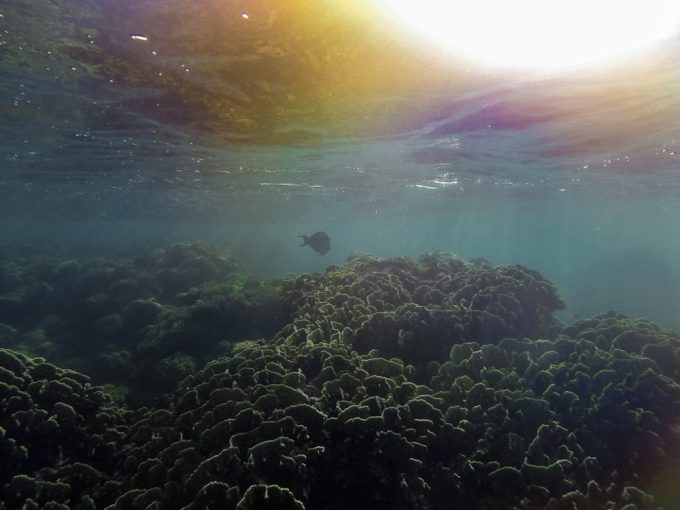
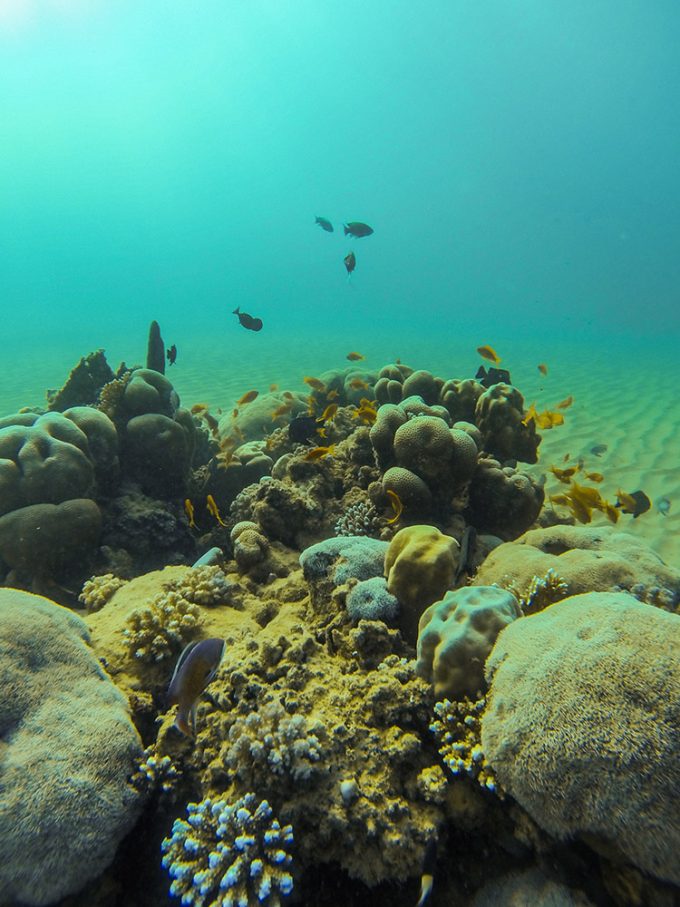
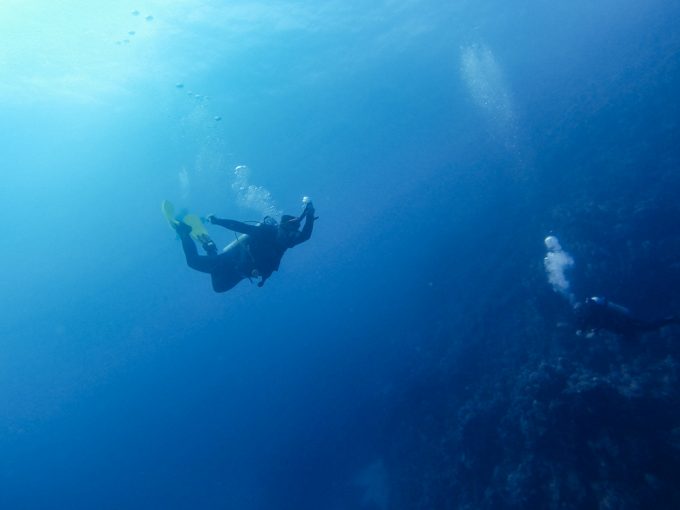
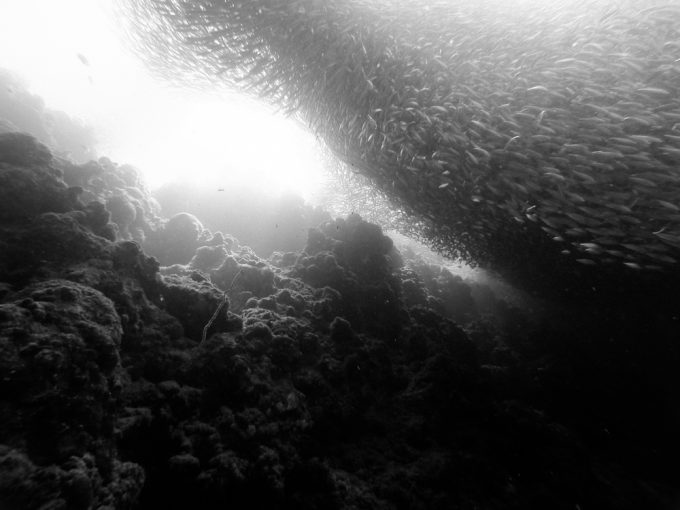
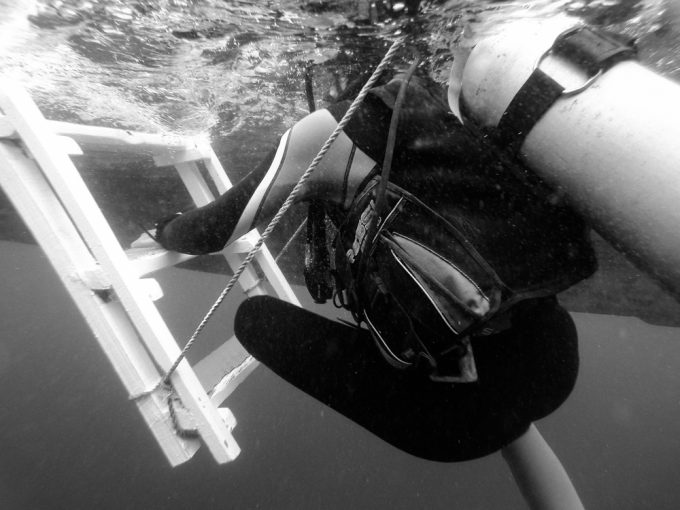



What do you think about the rx100(v?) with the underwaterhousing?
As I pointed out above, the Sony RX100 series is quite good for UW photography in general. It presents a good bridge between GoPro-like action cams and MILC/DSLR options. But for me, it’s still too big (with housing) and does not solve the issue of lighting and very high ISO performance. And if you buy a new camera one day, you need to also buy all new underwater gear. Though, it’s still a very good option.
Being a fairly recent diver with a gopro and low budget, i relate to your post. Luckily, i discovered that nikon’s underwater housing for the J1 /J2 is now very cheap: i got it at B&H for 50 usd plus a 18mm 1.8 lens for 180 usd and will try it for the first time next weekend when I’ll be in Cancun MX using a friend’s J1 as test unit. If I like it, I’ll get a used J1 or J2 for about 100 usd. Total cost of 320 which is slightly below the tg4 which i was considering too. My usual cameras are a sigma dp2, a ricoh gr d2, and a panasonic gh2, none of which are easy or cheap to get underwater (a used housing for the long-discontinued gh2 still sells for several hundred bucks) so jumping into nikon’s 1 system for this sole purpose seemed reasonable, even if i dislike its lack of controls. For wide shots i’ll still use my gopro
Steffen,
Very good compositions and you made the most from the tools you had available. I rented a Leica X-U type 113 for a trip to Maui and was very pleased with the results. That said, I am a snorkeler and not a diver; but the XU provided an ASPC sensor, fast lens, dedicated underwater mode, rated to 15 meters/49ft, and no housing needed so the kit remains compact. It is expensive, so I recommend renting before buying.
Thanks for your words. I checked out the XU but 15m doesn’t work for me. It’s good for snorkeling and shallow free dives, but not for scuba diving – sadly, because it really is a interesting action camera.
I am sorry to say but I am not impressed by the images.
I think you can do better with a Tg4.
I also read there is a new 1 inch sensor camera from sealife. Looks interesting: http://www.sealife-cameras.com/cameras/dc2000
I believe if you want to achieve a certain level of IQ underwater gear gets expensive. m43 in a housing is what I use and which is a good compromise between size/price and IQ.
Thanks for pointing me to the Sealife DC2000. I missed that recent announcement. It seems a interesting option: having the great Sony 1″ sensor and coming from a manufacturer that is dedicated to underwater photography. I’ll wait for reviews. I’m skeptical about the 31mm prime. Although I only use primes above surface and see myself not fiddling around with zooms underwater much, it may be too narrow. However, it may free oneself. I have to try it out and see more sample images.
I just recently played around with the TG4 in a shop. (Without manual) it seems that it’s not possible to set a minimum shutter speed or shoot in full manual mode. As you can not steady your position and 30+ m is usually very dark even during daylight and in tropical seas, I doubt the small sensor will make anything much better – better sure, but not good. The Sealife may be a better option.
And, as pointed out in my text, anything above this option, does not solve the problems but creates different ones.
That was a good read really. I can totally understand your point.
Too bad though, that the images actually do suffer from noise and lacking sharpness.
So even though I think I got your point, I’d still like to recommend that you try a little harder and find a better technical solution.
Ever thought about a nikonos nikon 1 system? Could be just your setup.
Thanks, Daniel, for your comment. Yes, I try better 🙂 As I said above, the GoPro is dead and will be replaced by something technically better. But I won’t go the DSLR/MILC+housing+light route. Not my vision, as described above.
For the Nikon 1 AWS (you mean that?), it’s only waterproof up to 15 m. I go down up to 40. That’s what I meant: One has not many options when it comes to uw photography.
Although I can’t promise that my future shots won’t have some grit, are noisy and not perfectly in focus. It’s a) technically challenging, b) physically and c) I’m not sure it supports my message. But yes, the obvious shortcomings should get fixed.
Being a fairly recent diver with a gopro and low budget, i relate to your post. Luckily, i discovered that nikon’s underwater housing for the J1 /J2 is now very cheap: i got it at B&H for 50 usd plus a 18mm 1.8 lens for 180 usd and will try it for the first time next weekend when I’ll be in Cancun MX using a friend’s J1 as test unit. If I like it, I’ll get a used J1 or J2 for about 100 usd. Total cost of 320 which is slightly below the tg4 which i was considering too. My usual cameras are a sigma dp2, a ricoh gr d2, and a panasonic gh2, none of which are easy or cheap to get underwater (a used housing for the long-discontinued gh2 still sells for several hundred bucks) so jumping into nikon’s 1 system for this sole purpose seemed reasonable, even if i dislike its lack of controls. For wide shots i’ll still use my gopro
Being a fairly recent diver with a gopro and low budget, i relate to your post. Luckily, i discovered that nikon’s underwater housing for the J1 /J2 is now very cheap: i got it at B&H for 50 usd plus a 18mm 1.8 lens for 180 usd and will try it for the first time next weekend when I’ll be in Cancun MX using a friend’s J1 as test unit. If I like it, I’ll get a used J1 or J2 for about 100 usd. Total cost of 320 which is slightly below the tg4 which i was considering too. My usual cameras are a sigma dp2, a ricoh gr d2, and a panasonic gh2, none of which are easy or cheap to get underwater (a used housing for the long-discontinued gh2 still sells for several hundred bucks) so jumping into nikon’s 1 system for this sole purpose seemed reasonable, even if i dislike its lack of controls. For wide shots i’ll still use my gopro
Very good the sardines shot.
The color ones could improve in my opinion with some post processing
Yes, the sardines shot is my favorite. We were diving through this cloud of millions of fishes for like 45min. It’s huge! Huger then huge. You can’t capture that on one photo. And all fishes were swimming synchronized like one giant animal. You could dive into them. They would open up in front of you and will close behind you and you’re surrounded by fishes. Amazing!
For the editing: what do you suggest? Like boosting colors, contrast and brilliance? See that banding in the free falling image? They’re already edited. I dropped the whole GoPro rant from my report but the files leave very little room for editing and are flat, dull and over-compressed by default. That’s why I wrote GoPro sucks for UW photography. You don’t even have AF, no viewfinder and a heavily distorted ultra-wide angle lens (15 mm) with heavy CA (as seen in the color images). But again, not many other choices.